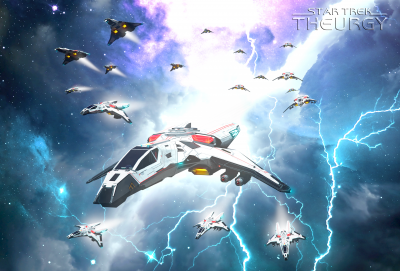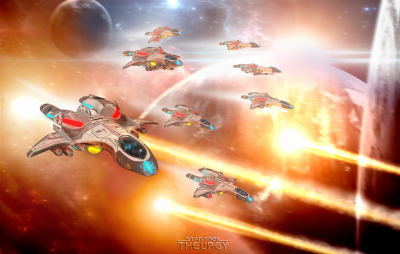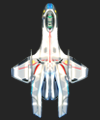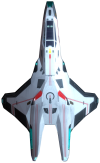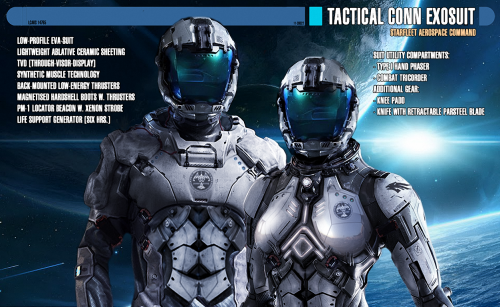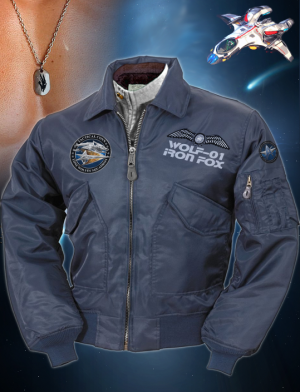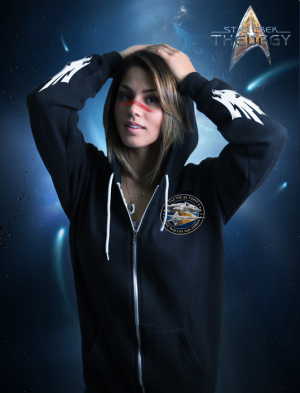Tactical CONN: Difference between revisions
From Star Trek: Theurgy Wiki
Auctor Lucan (talk | contribs) |
Auctor Lucan (talk | contribs) |
||
| Line 141: | Line 141: | ||
| style="background-color: #1E1617" colspan="4" | <font color="white"> '''TRIBBLE SQUADRON'''<br><small>Modded Type-8 Shuttles</small> | | style="background-color: #1E1617" colspan="4" | <font color="white"> '''TRIBBLE SQUADRON'''<br><small>Modded Type-8 Shuttles</small> | ||
|- | |- | ||
|<font color="white">'''Tribble Commander - Tribble-01'''<br> | |<font color="white">'''Tribble Commander - Tribble-01'''[[File:Wiki-Tribble-Shuttle.png|right|100px]]<br> | ||
Ens. [[Krystal Tancredi, callsign "Meony"|Krystal Tancredi]] (Human)<br> | Ens. [[Krystal Tancredi, callsign "Meony"|Krystal Tancredi]] (Human)<br> | ||
Callsign: Meony<br> | Callsign: Meony<br> | ||
|<font color="white">'''Shuttle Pilot - Tribble-02''' <br> | |<font color="white">'''Shuttle Pilot - Tribble-02''' [[File:Wiki-Tribble-Shuttle.png|right|100px]]<br> | ||
Ens. Ara Laurent (Human)<br> | Ens. Ara Laurent (Human)<br> | ||
Callsign: Aura<br> | Callsign: Aura<br> | ||
|<font color="white">'''Shuttle Pilot - Tribble-03''' <br> | |<font color="white">'''Shuttle Pilot - Tribble-03''' [[File:Wiki-Tribble-Shuttle.png|right|100px]]<br> | ||
CPO Kimberley Phillips (Human)<br> | CPO Kimberley Phillips (Human)<br> | ||
Callsign: Goshawk<br> | Callsign: Goshawk<br> | ||
|- | |- | ||
|<font color="white">'''Shuttle Pilot - Tribble-04''' <br> | |<font color="white">'''Shuttle Pilot - Tribble-04''' [[File:Wiki-Tribble-Shuttle.png|right|100px]]<br> | ||
PO1 Sophia Cortez (Human)<br> | PO1 Sophia Cortez (Human)<br> | ||
Callsign: Torp<br> | Callsign: Torp<br> | ||
|<font color="white">'''Shuttle Pilot - Tribble-05''' <br> | |<font color="white">'''Shuttle Pilot - Tribble-05''' [[File:Wiki-Tribble-Shuttle.png|right|100px]]<br> | ||
PO2 Dermot Lanier (Human)<br> | PO2 Dermot Lanier (Human)<br> | ||
Callsign: Frenchie<br> | Callsign: Frenchie<br> | ||
|<font color="white">'''Shuttle Pilot - Tribble-06''' <br> | |<font color="white">'''Shuttle Pilot - Tribble-06''' [[File:Wiki-Tribble-Shuttle.png|right|100px]]<br> | ||
CPO Kiera Thurmane (Human)<br> | CPO Kiera Thurmane (Human)<br> | ||
Callsign: Pole<br> | Callsign: Pole<br> | ||
Revision as of 10:08, 13 October 2016
The Tactical CONN department was where the Starfleet fighter pilots belonged, where space aviation and military/tactical knowledge went hand in hand. They worked very closely with both the CONN and Tactical departments and the department color was white.
Background Information: Tactical CONN
The formation of the Starfleet Aerospace Command was heavily influenced by the successful deployment of Peregrine-class fighters aboard the starships serving as carriers in the fleet, yet the USS Theurgy did not hold a squadron of Peregrine-class fighters aboard, but the more developed Valkyrie-class. Namely, the prototype Mk III version, a superior fighter that made use of recent advances in technology.
The year 2375 - after the conclusion of the Dominion War - the AC-409 Mk I Valkyries were deployed. These fighters were assigned to the USS Typhon (TNG game: Star Trek: Invasion). They were initially designed as a carrier-based fleet engagement craft. Initially, the design proved successful, with a high survivability rate matching the heavy fire power available to bring down larger ships. In learning that a full squadron of Valkyries would still require a lot of support for engagements of a Dominion-War level threat, Starfleet deemed that the attack fighter needed an upgrade. By 2381, these fighters were still being deployed in fairly limited numbers - shuffled around the fleet.
Another development at the time was that a group of influential admirals in the fleet demanded to form a new department that hand-picked the Conn officers with the most tactical training. It was the only way, they reckoned, to ensure that the fleet used the right kind of pilots for these fighters. The original score of 400 personnel - the fleets new Tactical CONN officers - served as the foundation for a new and more organized department for fighter pilots. They accepted only the highest scoring Conn or fight-trained Security or Tactical Cadets, and then dealt them another year of training in the fields they lacked from their Academy training. White became the chosen color for the department, and the admirals that rode this project into history became the core of the Aerospace Command.
Both the Mk I and II Valkyries used Rear Intercept Officers (RIOs). The efficiency in which the attack fighters were operated were doubled by allowing the pilots to focus solely on the maneuvers and weapons employment of the craft during a fight, allowing the RIO to handle comm traffic, emergency repairs, and tactic simulations. Among the improvements for the Mk II Valkyrie were a new ablative armor compound, improved power plant, and the employment of a hardpoint system beneath the wings. With the Mk II, the Valkyrie truly stepped into a class of her own. At the success of the Mk II and the fleet-wide deployment of the Valkyries in the fleet, Starfleet Command began looking into the Valkyrie with more interest. Initially, they had considered Tactical CONN another spear in Starfleet's arsenal. So when the project was given new funding, R&D went back to the drawing board to see what could be improved on an already formidable weapon.
The first step was to increase the command, control and reconnaissance capabilities of the design. Originally, the Valkyrie (both Mk I and Mk II) employed an Isolinear twin-core design computer system, with 372 Isolinear banks and 106 command preprocessors and data analysis units. This design was quite successful for the use of standard comm traffic control and tactical targeting, but newer sensor package upgrades intended for the Valkyrie were hampered by a core that was already at its limit for processing power. So, with the eagerness of little boys with a new toy to take apart, R&D began a computer system redesign from the ground up, which would lead to hull, engine, and weapons redesign, and end in an almost completely new Space Superiority attack fighter: the AC-409 Mk III Valkyrie.
By that time, Hyperjet Quantite Mk IV reactor cores were being successfully implemented in the experimental Knight-class interceptor. These core types could be sized variably (depending on the design requirements) while still maintaining a very high energy output. A twin-core design was drafted for the new Mk III, and projected numbers suggested the Mk III would see a 25% increase to power output than the Mk I & II series. With this increase in power output, a larger computer core system was designed. Utilizing bio-neural processors and relays, the original frame space needed for the computer systems was reduced, and spread out through the center-line of the craft. Computational capacity and storage was increased by another 30%, and a new tactical link-up library software system was implemented. The system provided a clearer and more accurate battlefield image for the pilot, and the integration was so effective that the RIOs were not needed any more - only one pilot was required in the cockpit.
With this new freedom of space within the spacecraft hull, R&D decided a more streamlined hull would benefit the pilot. Their new, sportier look reduced sensor cross-section and improved warp field stability for the twin quantite reactor cores. With the hull redesign came minor changes to weapons load-out: the arrangement of the standard Type-XII pulse phaser cannons and microtorpedo launchers in the Mk II changed only slightly to fit into the new spaceframe. The hard-point system was simplified, and the pulse phaser cell-magazine rack was switched from a vertical feed system to a horizontal feed system to combat original design flaws and jams during gravity-inducing combat maneuvers.
Lastly, one more weapon was added: a tetryon pulse phase cannon was installed on the underside of the cockpit within its own hull compartment. This cannon was installed for ground suppression roles, and to give the Valkyrie an added punch in the Space Superiority role. The drawback to the tetryon pulse phase cannon was its limited ammunition and craft maneuverability when utilizing the weapon. Though the weapon itself could effectively neutralize enemy engine and weapons systems as well as do considerable kinetic energy damage, the weapon itself failed at a remarkable rate when engaged in combat maneuvers. A straight-line course was required for the weapon to work effectively, limiting it to the dangerous Head-to-Head combat maneuver, and strafing of ground or orbital targets. With these weapon enhancements and increase in power, a slightly larger pair of shield generators were installed, increasing shield sustainable load to 390 isotons/second. The ablative armor was also thickened from 10.7 cm to 11.1 cm.
The top speed and warp capabilities of the Mk III remained virtually unchanged, but the increased power output from the new quantite cores benefited the improved avionics, sensor, weapons, and shield systems more than her speed. Despite this, the Valkyrie Mk III could easily go toe-to-toe with the fastest Interceptors currently in service. What she lacked in speed, she made up for in raw firepower.
As of 2381, the Mk III Valkyrie remained a prototype test model, but with the recent development in intergalactic politics and the potential Romulan threat, the project was pushed towards immediate deployment by Aerospace Command. So, since the new Theurgy-class starship - the USS Theurgy - was not only being fitted with an A.I. inter-phase, but with a fully operational (if small) fighter assault bay, the decision was made. The Theurgy was given a complement of sixteen Mk III fighters with their own Squadron Commanding Officer and a crew of thirty technicians hailing from Starfleet Operations or Engineering Corps.
The sixteen pilots were named the Lone-Wolves, and though decimated to only twelve pilots after their escape from Earth, the survivors remained - fighting to preserve the truth of the corrupted Starfleet Command.
Tactical CONN Positions
Tactical CONN were trained in aerodynamics, support craft, fighter engines, flight systems, meteorology, and navigation, as well as flight rules and regulations. They also received training in maintenance and supervision of ground crew personnel. They were trained in combat fighter tactics in space as well as atmospheres. They all began training with runabouts, shuttles, and transports so were qualified on all types before graduation.
Group Commander [Cag] [N/A For Playing]
The Group Commander was in charge of all things related to his Group's Tactical CONN personnel and their fighters, generally a responsibility of all Flight Wings assigned to a base or starship. The CAG was responsible for all the personnel assigned to the Group on the ship/facility, and ensuring that combat readiness, mission load outs, maintenance checks, and repairs were done so all fighters were mission ready. The CAG reported to the Commanding Officer or Executive Officer and was a member of the Senior Staff.
Wing Commander [N/A For Playing]
The Wing Commander was in charge of all things related to his Wing's fighters, generally a responsibility of over 30 attack fighters. As well, the Wing Commander was responsible for all the personnel assigned to the Wing on the ship/facility, and ensuring that combat readiness, mission specific load-outs, maintenance, and repairs were completed maximizing readiness. If more than 16 fighters were assigned to a ship, it could have had a Wing Commander. If the Wing Commander was the senior Tactical CONN officer assigned to the facility, starbase, or starship, they reported to the Commanding Officer or Executive Officer and were a member of the Senior Staff.
Squadron Commanding Officer [Sco] / Squad Leader [Informal Title]
This was the highest ranking rank on board the USS Theurgy. The SCO was in charge of all things related to his Squadron's fighters, generally a responsibility for 8 to 24 attack fighters [2 to 4 Flights]. The SCO was responsible for all the Tactical CONN personnel assigned to the Squadron on the ship/facility, and ensuring the combat readiness, correct mission specific load outs, maintenance checks, and repairs were done so all fighters were mission ready. A SCO reported to the CAG or Wing Commander. If the SCO was the senior Tactical CONN officer assigned to the starship, starbase, or facility they reported to the Commanding Officer or Executive Officer and were a member of the Senior Staff.
Flight Leader
The Flight Leader was in charge of all things related to his Flight's fighters, responsible for 4 to 8 attack fighters. The Flight Leader was also responsible for all the Tactical CONN personnel assigned to the flight, ensuring that all his fighters were combat ready, supervising maintenance and repairs on the Flight's attack fighters. The Flight Leaders reported to the SCO of their Squadron.
Element Leader
The Element Leader was the Tactical leader of a pair of attack fighters. An Element was the smallest unit used by Tactical Conn. Only on rare or desperate times would a pilot and his/her attack fighter be deployed as a lone craft. The Element Leader reported directly to the Flight Leader.
Squadron Organizational Charts
Tactical CONN was comprised of Air Groups, which held four Wings, and in each Wing, there were usually four squadrons. Air Groups served as planetary or starbase defence complements, with the high number of fighters suitable for the defence of large population nodes in the Federation. When commissioned to starships, the fighter complement was usually a single Wing or a couple of squadrons. Depending on the ship's class, a round saucer granted a more capacious Fighter Assault Bay, yet single-squadron fighter complements could be found on other starships that had either been retro-fitted as carriers or built with hangars within the engineering sections.
These single squadrons deployed alone from starships all had in common that they had a wolven theme to their names, since they operated in packs without the support from an entire Wing or Air Group. They could have squadron names like the Lone-Wolves on the USS Theurgy or the Grey Wolves on the USS Resolve.
See below for squadron organisational charts for known vessels in Star Trek: Theurgy. Since all fighter pilots at Starbase 84 were NPCs, they can be found on this page: Tactical_Conn_NPCs#The_23rd_Tactical_CONN_Air_Group_at_Starbase_84
The Lone-Wolves Squadron, commissioned to the USS Theurgy
Before the USS Theurgy's crew were named outlaws and persecuted across the Alpha quadrant, the Lone-Wolves Squadron consisted of sixteen fighter pilots and just as many Mk III Valkyries. See below for the current status of the Lone-Wolves:
| LONE-WOLVES SQUADRON AC-409 Mk III Valkyries | |||
| Squadron Commander - Wolf-01 Lt. Cmdr. Miles Renard (Vulpinian) |
Fighter Pilot - Wolf-02 [NPC] Ens. Kanti MacTavish (human) | ||
| Flight Leader - Wolf-03 [NPC] Lt. JG Fasha (Human) |
Fighter Pilot - Wolf-04 Ensign CJ Slayton (Human) |
Element Leader - Wolf-05 Unnamed Wolf |
Fighter Pilot - Wolf-06 Unnamed Wolf |
| Flight Leader - Wolf-07 Lt. JG Tessa May Lance (Human) |
Fighter Pilot - Wolf-08 Unnamed Wolf |
Element Leader - Wolf-09 Lt. JG Evelyn Rawley (Human) |
Fighter Pilot - Wolf-10 Unnamed Wolf |
| Former Element Leader - Wolf-XX [MIA] Lt. JG Thomas Ravon (Human) | |||
The Grey Wolves Squadron, commissioned to the USS Resolve
Before the USS Resolve' was thrown into unknown space by a spatial anomaly, the Grey Wolves Squadron consisted of eighteen fighter pilots and just as many RIOs. They flew Mk II Valkyries at first, but over the three-year voyage, the loss of many fighters forced them to form a secondary squadron, the surviving pilots flying Type-8 Shuttles with several modifications. The shuttle pilots that flew these shuttles were named the Tribble Squadron, and they were led by Krystal Tancredi, callsign "Meony", who reported to the SCO, Daniel Havenborn, callsign "Salvo".
| GREY WOLVES SQUADRON AC-307 Mk II Valkyries | |||
| Wolf-01 Squadron Commander Lt. Daniel Havenborn (Human) |
Wolf-02 Fighter Pilot Lt. JG Sanders (Human) | ||
| Wolf-03 Flight Leader Ens. K'Ren (Caitian/Human) |
Wolf-04 Fighter Pilot Lt. JG Daniels |
Wolf-05 Fighter Pilot Ens. Yurek (Vulcan) | |
| TRIBBLE SQUADRON Modded Type-8 Shuttles | |||
| Tribble Commander - Tribble-01 Ens. Krystal Tancredi (Human) |
Shuttle Pilot - Tribble-02 Ens. Ara Laurent (Human) |
Shuttle Pilot - Tribble-03 CPO Kimberley Phillips (Human) | |
| Shuttle Pilot - Tribble-04 PO1 Sophia Cortez (Human) |
Shuttle Pilot - Tribble-05 PO2 Dermot Lanier (Human) |
Shuttle Pilot - Tribble-06 CPO Kiera Thurmane (Human) | |
The Dor'GhItlh Squadron, commissioned to the USS Harbinger (shown as of February 2381)
Before the Harbinger's crew were named outlaws and persecuted across the Alpha quadrant, the Dor'GhItlh Squadron was only one of four squadrons in Starfleet's 104th Fighter Attack Wing. The squadron as of February 2381, before the first battle with the USS Calamity is listed below. At that point, the 48 pilots strong Wing commissioned to the Harbinger had been reduced to twelve pilots, and after the battle, they were only eight, since Eli Cunningham, Harry Ezi, Toman Fal, and Teena Mod were KIA.
| DOR'GHITLH SQUADRON, FEBRUARY 2381 AC-307 Mk II Valkyries | |||
| Wing Commander/Squadron Commander Lt Cmdr. Phanatos Kilinvoss (Human) Callsign: Phantom |
Fighter Pilot Ens. Christopher Slayton (Human) Callsign: Husker |
Element Leader Lt. JG Daniel Ritwer (Human) Callsign: Riptor |
Fighter Pilot Lt. JG Lukas B. Reed (Human) Callsign: Bleed |
| Flight Leader Ens. Andrew Sullivan (Human) Callsign: Smoke |
Fighter Pilot MCPO Frida Armistead (Human) Callsign: Freya |
Element Leader Ens. Gregory Tilliander (Human) Callsign: Titan |
Fighter Pilot Ens. Rillian Hav (Human) Callsign: Riptide |
| Flight Leader Lt. JG Eli Cunningham (Human) Callsign: Liquidus |
Fighter Pilot Ens. Harry Ezi (Human) Callsign: Hawk |
Element Leader Ens. Toman Fal (Trill) Callsign: Spectre |
Fighter Pilot CPO Teena Mod (Bolian) Callsign: Tempest |
Tactical CONN Exosuit
A Tactical CONN exosuit was a low-profile EVA suit with adjustable-length exoskeleton limbs and frames that used small overlapping sectioned sliding plates, which dynamically expanded and contracted the overlap distance of its many outer plates, both to adapt to the wearer's limb length and girth, and as the plates move in coordination with the wearer's body during general use. It consisted of three layers: closest to the skin was a liquid heat insulation layer, then a pressure-restraint layer, and finally the thermal micrometeoroid layer, reinforced with sheets of lightweight ablative ceramic. The role of the liquid heat insulation layer was, obviously, to keep the body at the occupant's preferred temperature. The pressure-restraint layer maintained appropriate internal air pressure, and prevented air from leaking out of the suit and provideed constricting pressure under extreme G forces. The outside layer protected the wearer from the extreme temperatures of outer space, lunar dust, and to some extent, energy weapons.
The exosuit also had a synthetic muscle technology with servomechanisms and a spinal stabiliser. The back of the suit also had two low-energy thrusters with a ten minute capacity, added with thrusters in the magnetized hard-shell boots. The PM-1 locator beacon on the helmet was fitted with a xenon strobe, generating 9,600 lumens for sake of visibility during rescue operations. The stand-alone life support generator would generate oxygen for six hours, but the exosuit also had an auxiliary oxygen system if the generator was damaged. An emergency battery powered a O2 analyzer and a carbon dioxide scrubber, with a total capacity of four hours oxygen supply.
The slim utility compartments by the hips and the sides of the legs contained the following:
- Holster for the pilot's Type I hand phaser [+ 2 extra power cells]
- Knee PADD (see below)
- Combat Tricorder
- Standard combat ration pack (14 days)
- Standard combat medical kit
- Knife with retractable parsteel blade
- 1 field communicator
- Emergency inflatable shelter (1 person)
- 2 half-liter pouches of drinking water
- Respirator/filter mask
Knee PADD
This item of a pilot's gear was essentially a wider and flatter version of the standard PADD issued by Starfleet, with bigger buttons for use with gloves. It was strapped to the pilot's thigh, where it could easily be seen during flight. It was used to record critical navigation instructions, pre-flight checklists, communication code frequencies, and other pieces of important information. During flight, it recorded the pilot's biological data and any conversation inside the cockpit of the aircraft. This data often proved valuable to rescue crews or accident investigators.
Through-Visor Display [TVD]
Critical flight data (course, speed, threats, etc.) was displayed for the flight crew on their helmet visors. This look-through display was known as TVD (Through-Visor Display). The TVD was extremely useful as it meant the crew did not have to lower their gaze from the combat environment when they needed this information.
Unlike a standard HUD (heads-Up Display) which was projected only on the forward canopy, the TVD could be seen no matter where the Aerospace crew looked, and the information displayed in the TVD was updated based on the orientation of the crew member's head. In other words, it showed the crafts heading straight ahead when the pilot looked forward, but to his right when he looked left. This feature was extremely helpful when searching for targets that might not lie directly in the craft's flight path.
Another unique feature of the TVD was its ability to look 'through' the craft. This was accomplished by linking into the craft's sensors to produce a holographic image of what was under the craft. When the pilot put the TVD on virtual mode, he could then look down and instead of seeing the instruments or the cockpit floor, he could actually see what he was flying over, along with all his standard flight information. Virtual mode was engaged with a switch which the crew member kept depressed for the duration of their 'look-through'. Once the switch was released, normal vision returned. This prevented the pilot from looking down at a moment when he really did need to see his instruments and not being able to.
The TVD had several different modes for each crew member, and the particular mode needed could be selected from the stick controls. The computer narrowed the options available based on the environment the aircraft was in to reduce erroneous selections. For instance, space flight modes were not available in atmosphere, landing mode was not available when there was no hard surface within 5,000 meters of the craft, etc.
The Fighter Assault Bay / Flight Hangar [Informal Term]
Below is the floor plan of the Fighter Assault Bay (more commonly called the Flight Hangar, the hangar etc.) in which the Tactical CONN squadron of Mk III Valkyries were housed and where the Theurgy’s fighter pilots usually hung out.
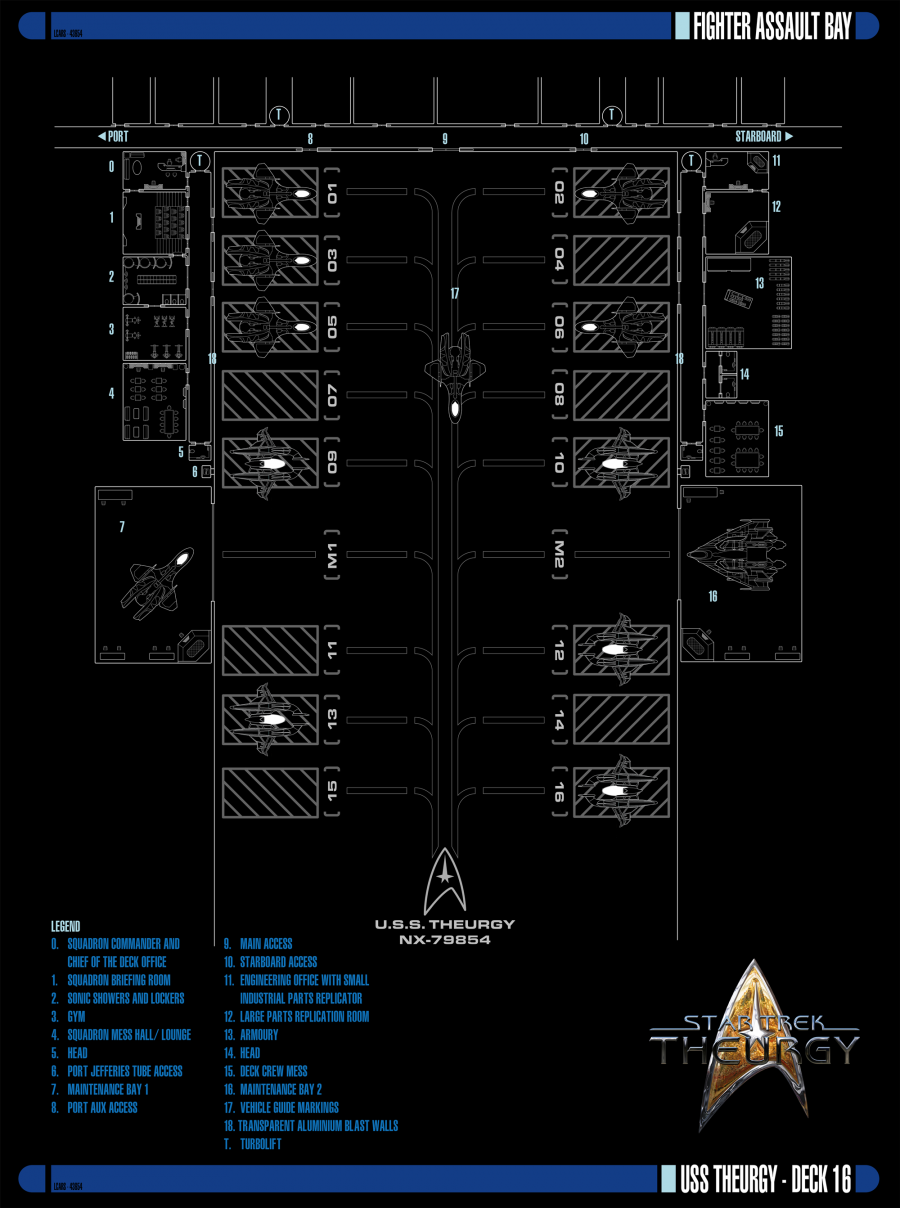
DeviantArt full resolution view: http://auctor-lucan.deviantart.com/art/Star-Trek-Theurgy-Fighter-Assault-Bay-507520121
Squadron Spirit
A Tactical CONN pilot was defined by a certain amount of self-confidence and self-respect for their own skills in regards to their training. Some pilots might have been mice outside of the cockpit, but because of training or inner strength, they turned into formidable piloting machines once they got into their Valkyries. The ones that withered under battle pressure were weeded out early in Tactical CONN Academy.
There was also the great trust they had in their fellow pilots; a 'pack' mentality that kicked in. On duty - especially in combat situations - more than half of their fighting ability came from the support provided by their Squadron. Off duty, there was a certain appreciation for the essence of life itself; a certain flare of enjoying life with more color and enthusiasm than necessarily their fellow Starfleet officers might. Day in and day out they would go out there and willingly throw themselves in front of bullets.
Tactical CONN courted death and faced losing friends every day, so there was a constant state of heightened adrenaline, and thus a greater appreciation for life. Their pack mentality generated some off duty tendencies as well, like wearing matching flight jackets, necklaces, or hoodies that bolstered their team spirit.
Common Terminology
Combat Geometry
- Angle Off - The difference between your heading and the ship you wished to attack in degrees
- Angle off Tail (AoT) - The angle between your flight path and the flight path of the ship you wished to attack
- Aspect Angle - The number of degrees between the tail of the other ship and your ship
- Range - The distance between your ship and the target ship
Attack Terms
- Closure Rate - The speed of your ship relative to the speed of the target ship.
- Cone of vulnerability - The area of space that put you in range of your enemy's weapons. The only cone worse than the "Cone of Silence".
- Corner speed - The speed at which a fighter/vessel could achieve its best turn radius
- Turn rate/ Turn radius - The number of degrees a fighter/vessel could pivot per second.
- Weapons Envelope - The area in which a weapon was effective. It was specific to the weapon and included maximum and minimum range.
Types of Pursuit
- Lag pursuit - The opposite of lead pursuit. You made a wider turn instead of a sharper one to a point just behind the tail of the target pursuit.
- Lead pursuit - Taking the path based on your prediction of the flight path of your target. You anticipated where it would be and altered your course to cross the target's flight path. Smaller or more maneuverable craft could get an advantage by taking sharper turns.
- Pure pursuit - Following closely the path of the target.This was the position you wanted to be in for torpedo and missile firing. Good also for closer range with phasers.
Pilot Chatter
- Bandit - Enemy vessel
- Bent - Sensors inoperative
- Bogey - Unknown vessel
- Buddy spike - Being tracked/targeted by friendly forces. Look out for friendly fire
- Bug out - Disengage
- Clean - No contacts
- Clear - No enemy threat to you
- Contact - Located target
- Mud spike - Being targeted by ground radar
- No Joy - No contact of target. Opposite of "tally"
- Target - That thing you are looking for or want to get rid of
- Tally - Opposite of "no joy". Target, bandit, or bogey has been sighted
Formation Flying
- Echelon Formation - Arrow head formation. Flight leader was the point of the arrow.
- Diamond Formation - Similar to above but there was a fighter directly behind the leader at the end to make a diamond shape.
- Line Astern Formation - Flight leader was in the front with the others behind at equal spacing intervals. Think of it as a column.
- Line Abreast Formation - Similar to "line astern" but fighters were arranged like a row. The flight leader was to the extreme left followed by the rest to his/her/its right.
Attack and Defensive Patterns
The patterns described in the previous post that adhered to the MVAM functionality of the Valkyries' base ship could also effectively be used when writing aerospace combat with a smaller Federation Attack Fighter. A recommendation was to write out the description of the specified maneuvres in some way so that the reader does not have to return here to check what actually happened in the post he/she was reading.
